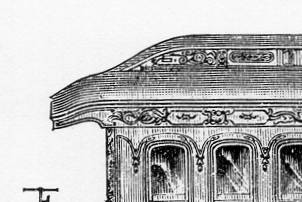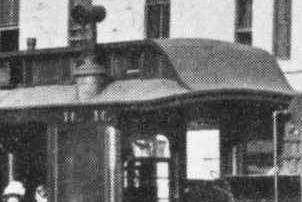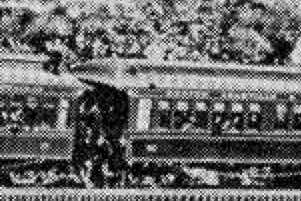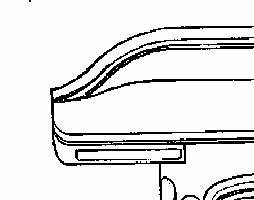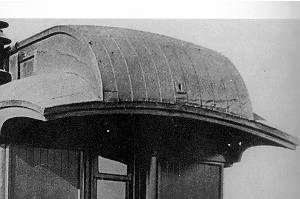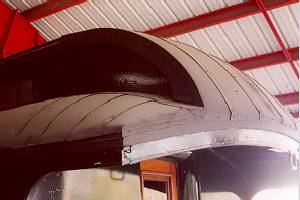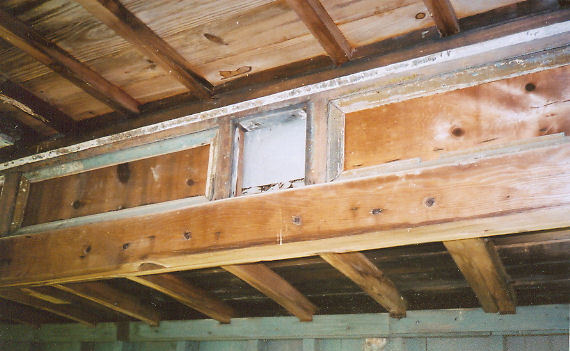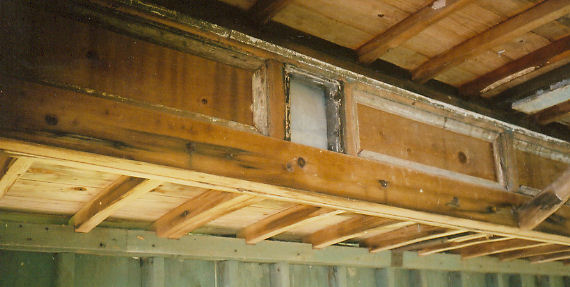A — CAutomatic Ventilator (Creamer’s). (Has its own page.) Belt-rail. A horizontal strip of wood on the outside of a passenger or street car immediately below the windows extending the whole length of the car body, or in some cases only that portion below the windows. (See left-most photo under “Double-pane Window.”) It is usually framed into the window posts and supports the window sills. Board and batten siding. A type of car sheathing where broad boards or panels are first applied to the car sides and narrow “battens” are then applied over the joints in the broad boards or panels. Body bolster. A cross-beam attached to the underside of a car body near the end which contains the apparatus that supports and stabilizes the car on its trucks. This apparatus generally consists of the body center plate and a pair of body side bearings. Body center plate. One of a pair of plates, originally made of cast iron, that support a car body on the center of its trucks. The center-pin passes through them but carries none of the strain except in emergencies, due to the male and female shape of the corresponding plates. Body side bearing. The upper one of the two side bearings; the one that is attached to the body bolster. Bogie. A term largely used outside North America denoting the wheeled apparatus supporting an 8-wheeled railway car. Within North America generally called a “truck.” Broken bullnose platform roof. (below) A variation of the bullnose platform roof with a break in the curve. Looks a little like a duckbill platform roof with the end drooping. It was once popular with Pullman.
Caboose. A car attached to the rear of all freight trains until 19___, for the accommodation of the conductor and trainmen, and for carrying the various stores, tools, etc. required on freight trains. In the 19th century sometimes called a conductor’s car or train-car. Until the advent of the side-bay about 19___, made with a lookout (later known as a cupola) to give the trainmen a view of the train. (And in the 19th and early 20th century to display train signals to the locomotive and trains following.) Caboose cars were either four-wheeled or eight-wheeled. A four-wheeled caboose was sometimes termed a cabin-car (and on a very few railroads, a way-car). A larger, eight-wheeled caboose was frequently provided with lockers, cooking-stove, writing-desk, and other conveniences for living. Carline, or carling. (below) A transverse [cross-wise] bar of wood or iron that extends across the top of a car from one side to the other to support the roof boards. In passenger cars, carlines are divided into several categories: main carlines, which pass completely across the car; short carlines or deck carlines, which are confined to the upper deck of the clerestory; and rafters, which are confined to the lower deck of the clerestory. The carlines of freight cars are sometimes called rafters.
Center-pin. (Also known as a king-bolt or king-pin.) A large bolt that passes through the body center plate and the truck center plate. The truck swivels around the center-pin, which normally has no nut or key at its bottom end, being held in place in the truck center plate through gravity. This feature has been utilized to lift a car body from trucks of one gauge and reinstall it on trucks of another gauge. [See our article on Ramsey’s Car Truck Shifting Apparatus.] Clerestory. (pronounced “clear-story”) That portion of a roof that sticks up higher than surrounding portions, hence the portion of a passenger car roof that rises above the roof proper, usually with windows in the sides for light and/or openings for ventilation. Syn. deck, dome, elevated, lantern, monitor, monitor-top, raised, upper deck, steamboat, Texas roof. The former, “deck” was so widely-used at the turn of the century that the 1898 Car-Builder’s Dictionary used that term exclusively. First used in American car framing about 1860, and widely used through the 1930s. The raised portion of a caboose or cabin-car was early termed a lookout, later a cupola. Clear-Story. The incorrect spelling of “clerestory” commonly used throughout most of the 19th century and well into the 20th. Creamer’s Automatic Ventilator. (Has its own page.) Creamer’s Emergency Brake. (Has its own page.) Cupola. A raised portion of a caboose or cabin-car to enable the train crew to keep a lookout over the train. In 19th century known as a lookout, and also used to display signal lights. After the coming of automatic air-brakes, to monitor air pressure and to apply brakes in an emergency. |
|||||||||||||||||
